| On my way to Airventure 2008 I decided to drop into the JDT Mini-Max factory, located in Nappanee Indiana. As you come off of I 20 and heads out on 19, you come upon an Amish community, it only seems fitting that in the middle of that community you find an airstrip that houses the JDT Mini-Max factory. For those of you who are not familiar with the Mini-Max line of aircraft, it is one of the oldest and most popular line of all wood aircraft in the world dating back to the early 70s. One year at Sun N Fun there were over 100 Mini-Max aircraft on display! Several years ago the design rights for the Mini-Max line of aircraft w 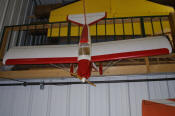 | | Mini Max EROS model | 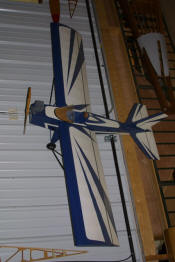 | | Mini Max model | 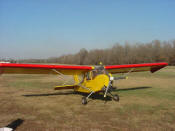 | | Hi Max spring aluminum landing gear. | 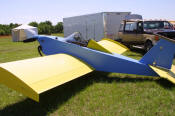 | | Partial canopy. | 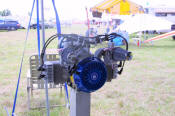 | | Hirth F33 |  | | HKS Aircraft engine. | as purchased by John Graber, and the factory moved to the Nappanee Airport in Nappanee Indiana. Which is where I found John Graber busy preparing a kit for shipping, he put down his tape gun and greeted me with a smile and an offer of a coffee. As I glanced around I couldn't help but notice a number of what looked like model airplanes decorating the walls. In fact they were scale replicas of the models that JDT Mini-Max produces. John then walked me through the history of the Mini-Max line of aircraft quickly explaining the differences from the earlier models to today's models. While there are six different designs in the Mini-Max series, there are really only two different configurations. The Mini-Max is an all wood mid-wing single place aircraft. The Hi-Max is a high wing version, both units use the same basic fuselage and construction techniques. John indicated that most older pilots seem to prefer the Hi-Max series for it's ease of entry and exit, it is also more stable in flight, offers better visibility, and is a little more comfortable to fly because it is enclosed. The only major drawback to the Hi-Max is the loss of about 5 miles per hour in cruise. The Hi-Max is offered in two different landing gear configurations, the standard gear which obtains its suspension from the tires, and an optional spring aluminum landing gear system manufactured by Great Plains, which is recommended if pilots are flying off of rougher fields. In 1995 the Eros 1650 was introduced, in both the Mini-Max and Hi-Max versions. The Eros is a beefier version, with the gross weight going from 550 pounds to 700 pounds. Which allows for the installation of more powerful and heavier engines such as the Rotax 503. John indicates there is also a V Max series which can be powered by Volkswagen engine conversions. The Mini-Max mid wing version of the aircraft also has two canopies available for it, one canopy completely encloses the pilot which would be used in colder weather. While the other convertible canopy is open on the top which is ideal for summer flying. A number of years ago a very light weight and reliable engine called the Zenoah was offered on the Mini-Max line of aircraft. This twin cylinder opposed engine is no longer available, but John has found a suitable replacement in the Hirth F33, during the tour of the factory he showed me the R&D work that is being done on a Hi-Max fuselage to accommodate the Hirth F33. John also indicates that a customer has recently installed an HKS twin cylinder 60 hp four stroke engine onto an Eros. John indicates that customers have built his airplane in as little as six weeks, but the average person will take between 450 and a 1000 hours to complete his or her kit. The planes all feature the same construction, which is very similar to that used in building would model RC aircraft kits. Everything is glued with T88 two-part epoxy which when dry is stronger than the word. All the wood supplied in the kits comes cut to the actual width and length, and is stamped with the number of the part. The customer then takes it wood traces the pattern onto the wood and then cuts or shaves it to match the plans. The whole aircraft is built section by section on a flat table. All of the control system linkages are also supplied in the kit is raw stock material. The customer again traces of the design and then using hey band saw cuts the material as required. The rudder cables are also supplied in a rule, which then has to be measured, swaged and Nicoed. The Teleflex cables used for elevator and aileron control, come ready to install. As I indicated John was preparing kids for shipping to a customer, it was very interesting to see what a complete kit looked like. I was also amazed that to ship a complete kit from the factory in Indiana to Michigan was only going to cost a couple of hundred dollars, with shipping costs out to the West Coast running $300-$350. Even shipping overseas runs only about $1000.00. John indicates that he has supplied a number of aircraft to overseas customers, including a customer in China who is near completion of his kit, and is looking seriously at the JDT Mini-Max line of aircraft for sales and distribution in China. John has had to make few changes to the Mini Max design which was originally developed by Wayne Ison, who has won numerous awards for his designs, and has been recognized for his contributions to the ultralight and experimental aviation community by associations such as E.A.A.. The only changes that John anticipates in the future to the aircraft may be the widening of the pilot cockpit area to accommodate larger pilots. As John and I were finishing up the interview on the Mini-Max and Hi-Max series of aircraft, I happened to notice an aircraft sitting in the back of the hangar. I remembered seeing it at Airventure a couple of years ago, and had an opportunity to do an interview with a gentleman by the name of Lowell Farrand. Lowell introduced me to AeroMax which is a very unique little single place aircraft. In the AeroMax the pilot basically straddles the aircraft, which is very reminiscent of another of Wayne Ison's designs the AirBike. John indicates the AeroMax is now up and flying, and he is just finishing off the flight testing program, and has found that the planes performance is very similar to that of the Hi-Max, and in fact replicates the performance of the original AirBike. With of course the difference between the two aircraft being that the AirBike used a steel fuselage, while the AeroMax uses all wood construction. Another advantage of the wood construction is that it gives another 14 inches of wing area because of the additional width of the fuselage where the wings attach. The wing used on the prototype AeroMax also has an extra wing bay, the reason for this is that the wings were originally designed to fit on a Mini-Max that was being used by Larry Israel to demonstrate the Citroen automotive aircraft engine conversion that he was looking at offering to the public as an economical replacement for the Rotax line of two-stroke aircraft engines. The prototype AeroMax is being powered by the Hirth F-33, twin cylinder opposed, two stroke, 50 hp engine, with electric start, using a belt drive reduction system. John reports that the engine smoothly at cruise but runs a little rough at idle. He also reports that it economical to operate, compared to the Rotax 503. John is using a three blade Kiev or Hot Prop, and has found it to be quiet and efficient. Cruise speed on the AeroMax at 5000 RPM comes in at around 60 mph. The plane climbs out between 700 and 900 ft./m, with the stall coming in at around 28 mph. The AeroMax uses standard stick and rudder taildragger controls, with a center mounted stick. The pilot can enter the cockpit from either side, and when seated straddles the fuselage with his legs located on the rudder pedals which are outside and forward of the cock pit.
John indicates that while this is a little breezy, it is very comfortable and gives a sense not unlike that of a motorbike. But for those pilots flying in colder weather a set of optional fairings for the rudder pedals will be offered, as well as a set of lexan wind deflectors located on the sides of the windshield. The brakes are operated via a single brake lever located on the joystick. The prototype AeroMax is equipped with an EIS engine monitoring system, airspeed indicator, altimeter and compass. The plane is equipped with two wing tanks, and comes with a site meter for a fuel gauge. The pilot flies on both tanks all of the time. The throttle is located on the left-hand side of the airplane right beside the pilot's knee. A seatbelt and shoulder harness are used for pilot restraint. John says "the AeroMax is designed for any size pilot, the bigger pilots just have a little more hanging out in the wind." Another thing that shorter pilots will find attractive about the AeroMax is that even at 5 foot six I was still able to see clearly over the nose, and visibility on either side of the plane was exceptional. The AeroMax can also easily accommodate pilots of over 6 feet with still plenty of headroom. John reports that the plane has very good ground handling characteristics for a tail dragger, but does require a little more pilot experience when landing in a cross wind, because of the enclosed fuselage and large tail. The AeroMax also comes with a set of drooped wingtips which contribute to its docile stall characteristics, and John indicates that with a little power on and nose up attitude he can fly the airplane comfortably down to 22 mph indicated.
For more information on the JDT Mini-Max line of aircraft contact; |